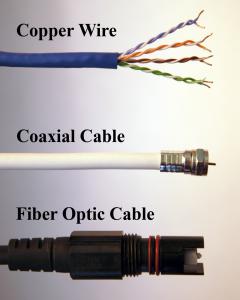Most of our homes are connected to the outside world in a number ways. We transmit and receive information in our home using telephones, televisions, the Internet and, more recently, smart speakers and devices
Telephone Technologies:
Wired Telephones
- Traditional telephones -- “POTS” (Plain Old Telephone System) -- use copper wires
- Cordless telephones use copper wires to the base station and radio spectrum for communications from the base station to the headset
- Voice Over Internet Protocol (VOIP) telephones (use the Internet to transmit voice signals)
Wireless Telephones
- Cell phones (use radio spectrum for communications from macro cell sites or so-called “small cells” to cell phones)
- Satellite phones (use radio spectrum for communications via satellites)
Television Technologies:
- Over-the-Air-TV
- Broadcast TV (using radio frequencies and analog or digital antennas to receive over-the-air broadcast signals)
Analog Cable TV
- With a set-top box (using coaxial cable)
- Without a set-top box (using coaxial cable and a TV with built-in cable technology)
Direct Broadcast (DBS) Satellite
- With a satellite antenna (dish) (using radio spectrum to connect satellites to a receiving dish and a cable from the dish to your TV)
Newer Television Technologies
- Streaming video (using so-called “smart TVs” and similar devices connected to the Internet via cables or wirelessly via Wi-Fi)
Internet Access Technologies:
Older Phone-line-based Systems (using copper wires)
- 56k Dial-up
- DSL (Digital Subscriber Line)
Cable-based Systems
- Cable modem (using coaxial or hybrid coaxial/fiber optic facilities connected a modem/router and on to your device via cables or wirelessly via Wi-Fi)
Satellite-based Systems (using radio spectrum to connect satellites to a receiving dish and a cable from the dish to your TV)
Newer Technologies
- Fiber Optic-based Systems (using fiber optic cables connected to a modem and a router and on to your device via cables or wirelessly via Wi-Fi)
- Fixed Wireless Systems (using radio frequencies to connect a transmitter site to a receiving antenna connected to a modem and on to your device via cables or wirelessly via Wi-Fi)
What Connects Your Home to the Service Provider
The traditional technologies, and the new technologies, both rely on some of the same conduits to transmit signals to and from your home. These include:
Copper Wire -- Twisted pair (traditional “POTS” system)
Coaxial Cable -- Regular cable
Fiber Optic Cable -- Faster transmission speeds than other systems
Hybrid -- Fiber optic cable in the main provider network connected to regular coaxial cable to your home
Radio Signals -- Satellite television, and wireless devices: cellular telephones, broadband wireless mobile cards, and mobile wireless PDA phones

Connecting Your Home
In today’s ever-evolving marketplace for telephone, video (TV), and Internet services, there are now multiple devices and ways that connect residents in the County to these services. Because there are so many options, choosing a technology and service provider that is the best fit for one’s specific needs can be difficult.
The Department of Cable and Consumer Services along with the Consumer Protection Commission, would like to help you understand these new offerings so that you can make informed choices for your telephone, television and Internet services.
We hope the webpages below will give you some of the information you need to make informed choices about how to navigate today’s complicated communications landscape and end up with the telephone, video and Internet services that work best for you.
Also, please note that our department gives you the opportunity to participate in free events that are designed to educate you about many of these technologies and services.
Additional Information
Tips for Buying a New TV (FAQ)

